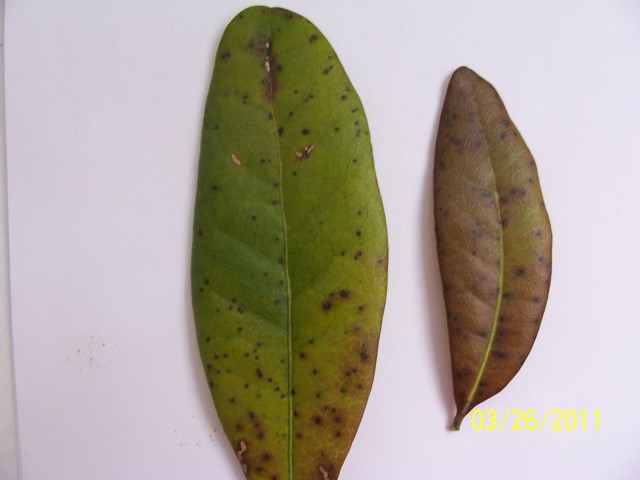Question
 Spotty Leaves1
Spotty Leaves1
We live in Williamsburg, Virginia and we have a Southern Live Oak that is about 8 years old. We are seeing that the leaves are getting spotty, then they turn brown and fall off. This is happening to mature leaves as well as new leaves. We have a yellow-bellied sap sucker that loves this tree and as such has put a fair amount of holes in it. We are wondering if there is anything we can do to stop the tree from loosing it's leaves as it is getting very sparse. I have attached an image of a green leaf with the spots and a brown leaf with the spots. These spots are not raised at all. The leaf feels smooth even over the spots. Thank you for your help.
AnswerLooks like a leaf spot fungus.
There are several leaf spot fungi that will infect an oak. Leaf spot is a common descriptive term applied to a number of diseases affecting the foliage of ornamentals and shade trees. The majority of the leaf spots are caused by a variety of fungal pathogens but some are caused by bacteria.
The primary symptom of a leaf spot disease is spots on foliage. The spots will vary in size and color depending on the plant affected the specific organism involved, and the stage of development. Spots are most often brownish, but may be tan or black. Concentric rings or a dark margin around the spot may be present. Fungal bodies may appear as black dots in the center of the spots. Over time the spots may combine to enlarge to form blotches. Leaves may yellow and drop prematurely.
The organisms that cause leaf spots survive in fallen infected leaves and twigs. Some may remain in dead twigs on the tree. During wet weather, spores are released which may splashed or be windblown onto newly emerging tender leaves where they germinate in the moisture and infect the leaf. Overhead watering late in the day or during the night, heavy dews and close spacing of plants prolong wetting of the leaf surface and provide more opportunities for fungal or bacterial infections.
Leaf spots are largely an aesthetic problem as few leaf spots seriously damage the host. Also control is seldom achieved after the infection has started.
Remove infected leaves and dead twigs. Raking up and disposing of infected leaves as they drop and pruning out dead twigs can help control the disease by removing spores that can reinfect the new leaves. This will not cure the problem but it can help minimize infections.
In rare cases of severe infection where the size and value of plants make it practical, applications of fungicides may be helpful. Generally fungicidal control is warranted if: 1) repeated defoliation occur in one year or subsequent years, 2) the plant is under stress, 3) the plant is in decline, 4) the plant is a needled evergreen or 5) the disease is black spot of roses. Sprays will not cure the infection but protect leaves from becoming infected. To be effective fungicidal sprays must be begun at bud break before symptoms are noted and be continued at intervals specified by the label (usually 10-14 days) through the period of spring rains. Spraying after infection is present will provide little benefit.
The following fungicides are labeled for use on oak to control oak leaf spots: Bordeaux mixture, Daconil Ultrex, Daconil Weather Stik 6F, Rose and Shrub Disease Combo, Dithane M-45 80W, Fore 80W. Always follow label recommendations and precautions.






